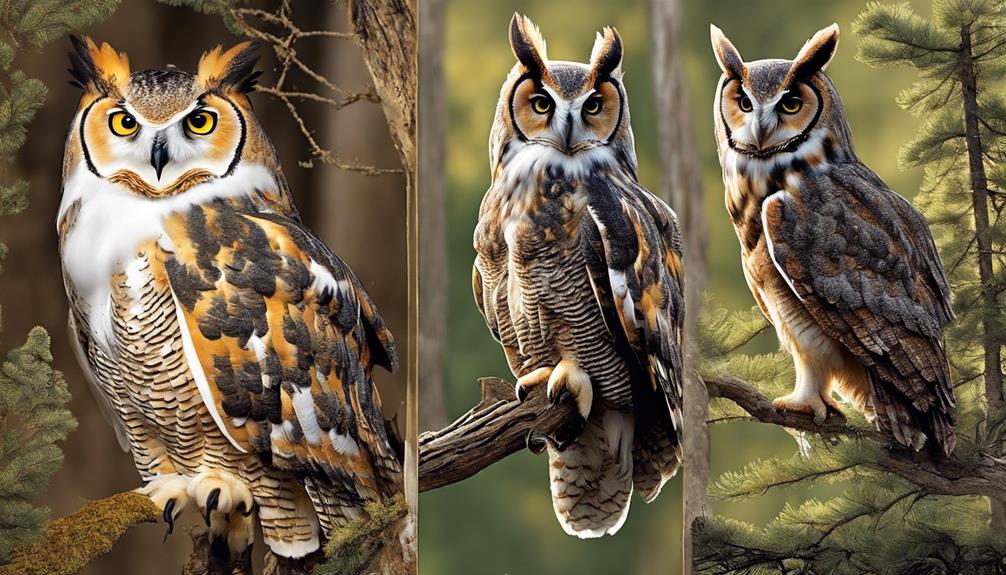I’m here to help you understand the size of Turkish Boz Shepherds. Female dogs are typically between 26-33 inches tall, while males usually range from 31-38.5 inches in height. These dogs have a commanding presence, with males exuding strength and authority, and females displaying grace and agility. They have a strong and noble head, with almond-shaped, expressive eyes and a well-defined stop. Their muscular neck supports their head, and they have a lean, well-muscled body that enhances their agility. The forequarters provide a solid foundation for movement, while the hindquarters with proper hip angles optimize their efficiency. Turkish Boz Shepherds come in a variety of colors and require regular grooming. Their gait is a combination of power and grace, showcasing their noble temperament. This overview of their size and characteristics is just the beginning of getting to know these remarkable dogs.
Key Takeaways
- Turkish Boz Shepherds reach heights of 26-38.5 inches, males exude strength, females possess grace.
- Majestic stature commands attention in Turkish Boz Shepherds, reflecting strength and nobility.
- Proper body proportions, square profile, and lean, muscular build enhance agility and functionality.
- Well-developed forequarters and hindquarters provide foundation for speed, agility, and endurance.
- Coat comes in various colors, requires maintenance, and offers protection and insulation for varying climates.
Size and Proportion
When considering the size and proportion of Turkish Boz Shepherds, their height range for females falls between 26-33 inches, while males typically stand 31-38.5 inches tall. These majestic creatures exhibit a remarkable stature that commands attention.
The Shepherd's size plays an important role in its role as a protector and guardian. The male Boz Shepherds, with their towering presence, exude strength and authority, while the females, though slightly smaller, possess a grace and agility that are equally impressive. Understanding the nuances of their size enables us to appreciate the unique characteristics of this breed.
Size isn't just a physical attribute for these Shepherds; it defines their essence and purpose. As we explore further into the world of Turkish Boz Shepherds, their size becomes a defining feature that sets them apart in the domain of canine companions. Size indeed matters when it comes to these magnificent creatures.
Head Characteristics
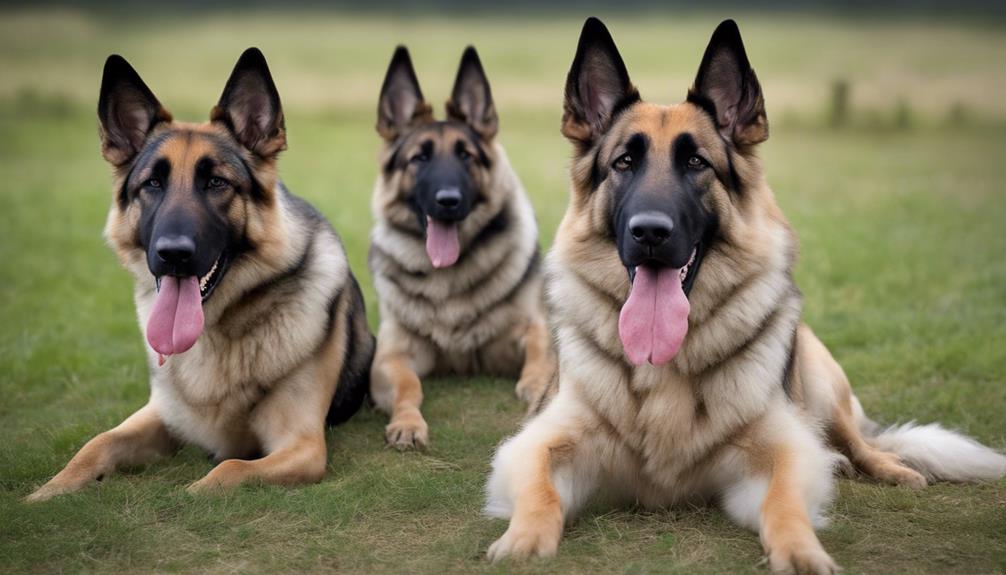
The Turkish Boz Shepherd's head, characterized by strength and nobility, showcases a slightly rectangular shape and well-defined features. One of the most striking aspects of their heads is the dark, almond-shaped eyes that exude intelligence and alertness. These eyes aren't only beautiful but also serve a practical purpose, allowing the Boz Shepherd to keenly observe their surroundings.
The breed's head also includes a well-defined stop, which is the point where the forehead meets the muzzle, creating a distinct angle. Additionally, the muzzle is proportionate to the skull, contributing to the breed's balanced and harmonious appearance. The ears of the Turkish Boz Shepherd are medium-sized, triangular in shape, and set high on the head, often dropping down close to the cheeks.
When you look at a Turkish Boz Shepherd's head, you'll notice a calm and soulful expression that mirrors their intelligent and perceptive nature.
Neck, Topline, Body Structure
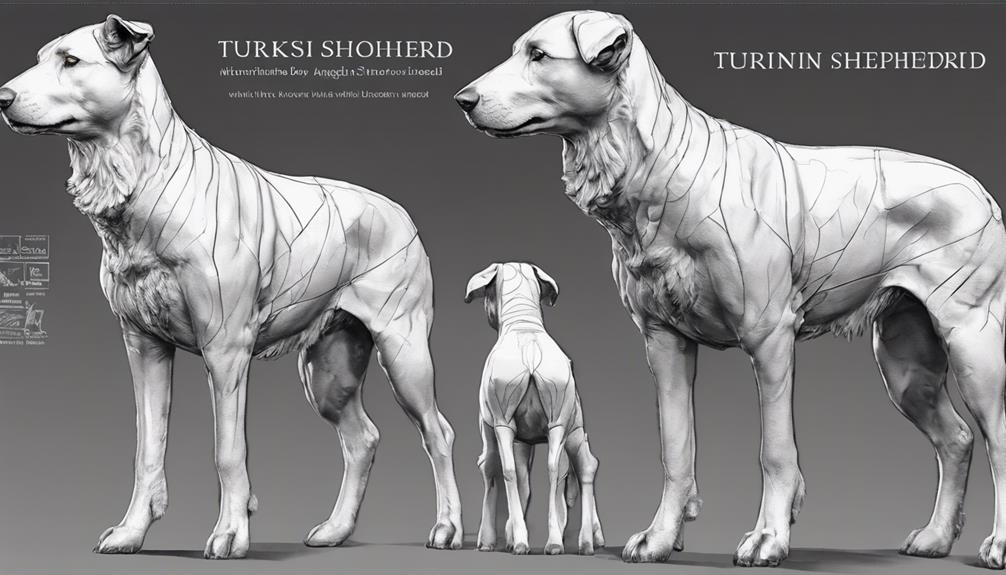
Moving from the head characteristics, we now focus on the neck, topline, and body structure of the Turkish Boz Shepherd, essential components that contribute to its overall strength and agility.
- The Turkish Boz Shepherd possesses a strong, muscular neck that complements its robust bone structure, providing the necessary support for its head and facilitating efficient movement.
- A level and sturdy topline are indicative of a well-balanced and powerful body structure in this dog breed, ensuring stability and endurance during various tasks.
- The lean, well-muscled body of the Turkish Boz Shepherd not only enhances its agility but also contributes to its majestic appearance, embodying strength and grace in equal measure.
The harmonious balance between the neck, topline, and body structure of this breed reflects its agility, strength, and functionality as a guardian and working dog. The Turkish Boz Shepherd's square profile further emphasizes its structural integrity, making it a formidable yet elegant presence in any setting.
Forequarters Anatomy

Exploring the muscular forequarters anatomy of the Turkish Boz Shepherd reveals the foundation for its agile and powerful movement capabilities. The forequarters, including the shoulders, upper arms, and elbows, are well-developed and strong, essential for the dog's balance and coordination.
The angulation of the forequarters is key to the dog's gait and overall functionality, impacting its ability to cover ground efficiently and smoothly. Properly structured forequarters are necessary for the Turkish Boz Shepherd's speed, agility, and endurance in various tasks and activities.
The strong forequarters support the dog's powerful movements, allowing it to excel in tasks that require strength and agility. Understanding the anatomy of the forequarters is crucial for appreciating the Turkish Boz Shepherd's impressive capabilities and performance in various activities.
Hindquarters Structure
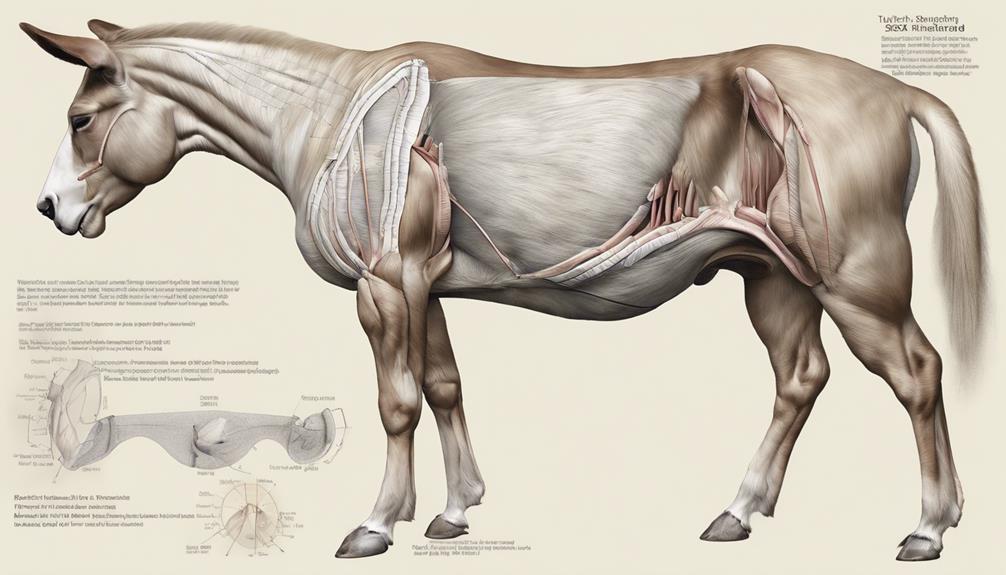
When evaluating the Turkish Boz Shepherd's hindquarters, two vital aspects to ponder are the hip angle and tail set.
The hip angle plays a significant role in the dog's movement efficiency and overall agility.
Additionally, examining the tail set helps determine the breed's balance and functionality during various activities.
Hip Angle Importance
Ensuring the proper hip angle in Turkish Boz Shepherds is essential for enhancing their hindquarters' structure and maximizing their overall movement capabilities.
- Correct hip angles in Turkish Boz Shepherds enable them to generate ideal power for activities like running, jumping, and turning.
- A well-aligned hip joint enhances agility, balance, and overall movement efficiency in these dogs.
- Incorrect hip angles may result in poor gait, reduced speed, and an increased risk of hip dysplasia or other joint problems.
Tail Set Evaluation
Proper evaluation of the tail set in Turkish Boz Shepherds plays an essential role in gauging their hindquarters structure for breed standard conformation. The tail set should align seamlessly with the natural slope of the croup, neither held too high nor too low.
A correctly positioned tail enhances the overall balance and movement of the dog, contributing to its grace and agility. Evaluating the tail set is pivotal in determining whether a Turkish Boz Shepherd meets the breed's conformation standards.
It's essential to observe how the tail complements the dog's hindquarters, as it serves as an important indicator of proper breed type and structure. By focusing on the tail set during evaluation, breeders and judges can ensure that Turkish Boz Shepherds exemplify the desired conformation traits.
Coat Type and Color

The Turkish Boz Shepherd's coat, with its short to medium length and dense texture, requires weekly brushing for maintenance. When it comes to the coat type and color of this Livestock Guardian breed, here are some key points to take into account:
- Acceptable Colors: The Turkish Boz Shepherd can come in a variety of colors, including white, red, grey, fawn, and cream. These colors help the dog blend in with different environments while performing its guardian duties.
- Seasonal Variations: The coat of the Turkish Boz Shepherd may undergo seasonal changes in thickness and shedding. Understanding these variations can help in managing grooming routines effectively throughout the year.
- Protection and Insulation: Beyond aesthetics, the coat of the Turkish Boz Shepherd serves a practical purpose by providing protection and insulation. Whether in hot summers or cold winters, this coat helps the dog adapt to varying climates while safeguarding the livestock under its care.
Gait and Temperament
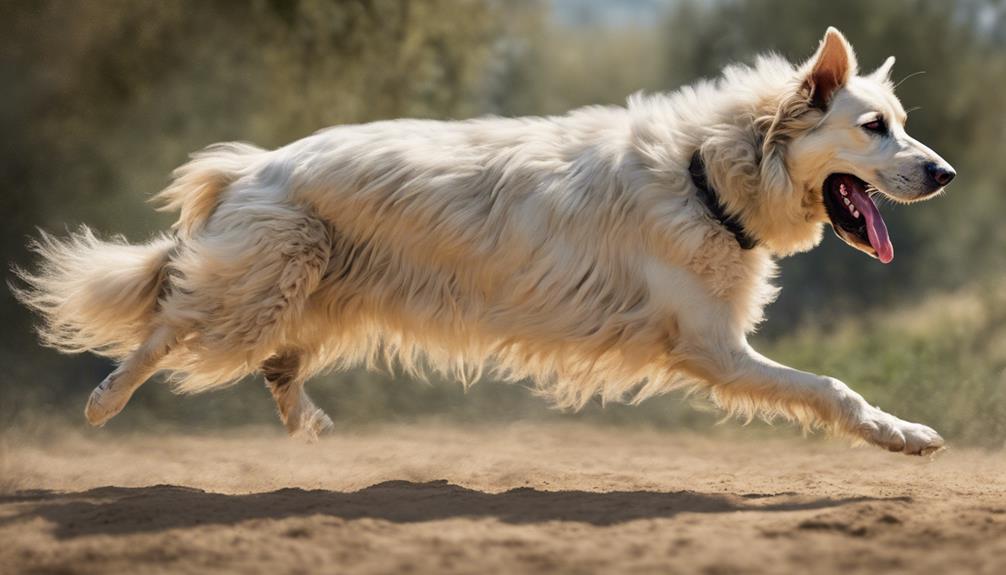
The Turkish Boz Shepherd's gait is a fascinating blend of power and grace, showcasing its agility and strength in motion. Its noble temperament complements its purposeful strides, reflecting a calm and intelligent nature that aids in its role as a capable guardian.
Understanding the breed's gait and temperament sheds light on its behavioral quirks, emphasizing the importance of these traits in its working and protective responsibilities.
Gait Characteristics Overview
Exhibiting a harmonious blend of strength, power, and fluidity, the Turkish Boz Shepherd's gait showcases impressive agility and speed.
- Their speeds ranging from 27-35 mph, some can even reach 40 mph, highlighting their remarkable agility and swiftness.
- With the ability for rapid direction changes, they prove to be versatile and efficient in various tasks.
- Maintaining a level backline during movement signifies proper structure and functionality, a trait deeply ingrained in their heritage as livestock guardian and shepherd dogs.
Temperament Traits Explained
With their remarkable agility and swift movements, the Turkish Boz Shepherd's temperament reflects a blend of calmness, intelligence, and perceptiveness. These shepherd dogs exhibit a moderate to high energy level, which is balanced by their attentive and composed nature. Their ability to swiftly change directions showcases their adaptability and quick thinking, making them versatile in various situations.
The Turkish Boz Shepherd's temperament aligns with their role as capable defenders, showing a keen awareness of their surroundings and a thoughtful approach to interactions. This breed's energy level, combined with their calm demeanor, makes them well-suited for tasks requiring both agility and a steady temperament.
Behavioral Quirks Clarification
Moving through various tasks and interactions, the Turkish Boz Shepherd's behavioral quirks, particularly in gait and temperament, reveal a distinctive blend of strength and agility.
- The Boz Shepherd's gait showcases a balance of power, speed, and agility, allowing it to reach impressive speeds of 27-40 mph.
- Its deep chest and well-muscled build contribute to a fluid movement with a level backline, reflecting ideal balance.
- Understanding these behavioral issues related to gait provides insight into the breed's functionality and physical capabilities.
Frequently Asked Questions
How Big Do Turkish Boz Shepherds Get?
Turkish Boz Shepherds can grow impressively large, with females standing 26-33 inches tall and males reaching 31-38.5 inches. Males typically weigh 140-200+ lbs, while females range from 100-170 lbs. These majestic dogs exhibit strength and grace in their size.
What Is the Difference Between a Turkish Boz Shepherd and a Kangal?
When comparing a Turkish Boz Shepherd to a Kangal, the Kangal stands out for its larger size and weight. Despite similarities in loyalty and protective instincts, the Kangal tends to exhibit more dominance, reflecting unique breed characteristics.
What Are the Different Types of Anatolian Shepherds?
Anatolian Shepherds have two main types: Kangal and Akbash. Kangal, larger and robust, excels in protection, while Akbash, smaller and agile, is adept at guarding livestock. Both share a rich history as Turkish livestock guardians for centuries.
Are Anatolian Shepherds Affectionate?
Yes, Anatolian Shepherds are incredibly affectionate. They express love through their protective instincts and strong bonds with their family. They enjoy physical closeness, cuddling, and gentle interactions with children and other pets, making them wonderful companions.
How Big of a Threat Are Coyotes to Turkish Boz Shepherds?
Turkish Boz Shepherds are at risk from different types of coyotes. These predators can pose a significant threat to the safety of the shepherd dogs, particularly when they are guarding their flocks. It’s important for shepherds to be vigilant and take measures to protect their dogs from potential coyote encounters.
Conclusion
Understanding the size and characteristics of a Turkish Boz Shepherd is essential for proper care and training. Their robust build and majestic appearance make them a distinctive and impressive breed.
By knowing the key features such as coat type, gait, and temperament, you can better appreciate and care for these magnificent dogs.
Remember, a well-informed owner is a happy owner, ready to provide the best for their loyal Turkish Boz Shepherd companion.






